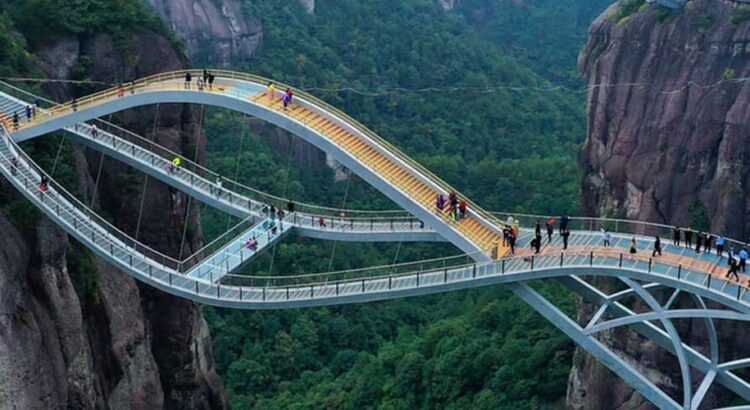The Ruyi Bridge is an iconic landmark located in the Wulingyuan Scenic Area in Zhangjiajie, China. It is a pedestrian glass bridge that spans across a deep valley and offers breathtaking views of the surrounding natural beauty.
The bridge is known for its unique design, featuring a curved shape resembling the Chinese traditional “ruyi” symbol, which represents good luck and prosperity. It is made entirely of glass, providing visitors with a thrilling experience of walking above the picturesque landscape below.
With a length of approximately 300 meters (984 feet) and a width of 6 meters (20 feet), the Ruyi Bridge is one of the longest and widest glass bridges in the world. It is suspended at a height of around 350 meters (1,148 feet) above the ground, providing visitors with stunning panoramic views of the mountains, forests, and cliffs of Zhangjiajie.
The bridge attracts visitors from around the world who come to admire its architectural beauty and enjoy the adrenaline rush of walking on a transparent structure. It has become a popular tourist attraction, offering visitors a unique and thrilling experience in the heart of the Zhangjiajie National Forest Park, a UNESCO World Heritage Site.
In addition to its impressive architecture, the Ruyi Bridge is equipped with various safety features, including multiple layers of tempered glass and a strict visitor capacity limit. It is advisable to check the availability and reservation requirements in advance if you plan to visit the Ruyi Bridge, as access may be restricted due to high demand and weather conditions.
How to get there
To reach the Ruyi Bridge in Zhangjiajie, China, you can follow these general guidelines:
- Fly to Zhangjiajie: The nearest airport is Zhangjiajie Hehua Airport (DYG), which is well-connected to major cities in China. You can find domestic flights to Zhangjiajie from cities like Beijing, Shanghai, Guangzhou, and Chengdu.
- From Zhangjiajie City: Once you arrive at Zhangjiajie, you can travel to the Wulingyuan Scenic Area where the Ruyi Bridge is located. You have a few options:
- By Bus: Take a bus from Zhangjiajie Central Bus Station to Wulingyuan. The journey takes around 40 minutes. From Wulingyuan, you can take a local bus or taxi to the Ruyi Bridge.
- By Taxi: Hire a taxi from Zhangjiajie to the Wulingyuan Scenic Area. It’s advisable to negotiate the fare with the driver beforehand.
- Wulingyuan Scenic Area: Once you reach the Wulingyuan Scenic Area, there are shuttle buses available to take you to the entrance of the Ruyi Bridge. The bridge is located within the Zhangjiajie Grand Canyon Scenic Area, and you may need to purchase an entrance ticket to access it.
It’s important to note that transportation options and routes may vary, so it’s recommended to check for the most up-to-date information before your visit. Additionally, consider that the Ruyi Bridge is a popular attraction, and there may be specific entry requirements, time slots, or visitor limits. It’s advisable to plan your visit in advance and make any necessary reservations to ensure a smooth experience.
Things to do
There are several activities and attractions in the surrounding area that you can enjoy. Here are some things to do:
- Walk on the Ruyi Bridge: The main attraction is, of course, walking on the Ruyi Bridge itself. Experience the thrill of walking on the transparent glass bridge and admire the breathtaking views of the Zhangjiajie National Forest Park below.
- Explore the Zhangjiajie National Forest Park: Take the opportunity to explore the stunning natural beauty of the Zhangjiajie National Forest Park. It is known for its towering sandstone pillars, lush forests, and picturesque landscapes. You can hike on the numerous trails, visit other scenic viewpoints, and enjoy the serene atmosphere.
- Ride the Bailong Elevator: Located nearby, the Bailong Elevator is the world’s tallest outdoor elevator. It takes you up to Yuanjiajie, a scenic area within the Zhangjiajie National Forest Park, where you can enjoy panoramic views and visit other attractions like the Avatar Hallelujah Mountain.
- Visit Tianzi Mountain Nature Reserve: Explore Tianzi Mountain, another part of the Zhangjiajie National Forest Park. It offers stunning views of the sandstone peaks and valleys, and you can take a cable car or hike to the summit for breathtaking panoramic views.
- Explore the Yellow Dragon Cave: Located close to the Ruyi Bridge, the Yellow Dragon Cave is a vast limestone cave complex with magnificent stalactite formations, underground rivers, and unique rock formations. Guided tours are available to explore the cave’s chambers and marvel at its natural wonders.
- Experience local culture: Take the opportunity to immerse yourself in the local culture of the area. Visit nearby villages and interact with the friendly locals, try traditional cuisine, and attend cultural performances to get a glimpse of the region’s heritage.
These are just a few of the many things to do in the area around the Ruyi Bridge. The combination of natural beauty, adventure, and cultural experiences makes it a memorable destination for travelers.
Things not to forget
Comfortable footwear, Weather-appropriate clothing, Sun protection, Drinking water and snacks, Camera or smartphone, Cash and identification & Travel essentials: Remember to bring essentials such as a backpack or daypack to carry your belongings, a reusable water bottle, a power bank for charging electronic devices, and any necessary medications or personal items you may need.
By keeping these items in mind, you’ll be well-prepared for your visit to the Ruyi Bridge and the surrounding area, ensuring a comfortable and enjoyable experience.
Best time to visit
The best time to visit the Ruyi Bridge and the surrounding Zhangjiajie area is during the spring (April to May) and autumn (September to October) seasons. Here’s why:
Spring: In spring, the weather in Zhangjiajie starts to warm up, and the natural scenery comes to life with blossoming flowers and lush greenery. The temperatures are moderate, ranging from around 15°C to 25°C (59°F to 77°F), making it comfortable for outdoor activities and walking on the Ruyi Bridge. However, do note that April can be slightly rainy, so it’s advisable to pack a light raincoat or umbrella.
Autumn: Autumn is another excellent time to visit as the temperatures cool down, and the foliage transforms into beautiful hues of red, orange, and yellow. The weather is generally pleasant, with temperatures ranging from 10°C to 20°C (50°F to 68°F). The clear skies and vibrant colors create picturesque views, enhancing your experience on the Ruyi Bridge and in the surrounding areas.
Both seasons offer favorable weather conditions for outdoor exploration and hiking, allowing you to fully appreciate the natural beauty of the Zhangjiajie National Forest Park and its attractions. The moderate temperatures and reduced humidity make it more comfortable for walking on the glass bridge and enjoying other activities in the area.
It’s worth noting that the Ruyi Bridge and Zhangjiajie can be visited year-round, and each season has its own unique charm. However, summer (June to August) can be hot and humid, with more crowds, while winter (December to February) can be colder and less foliage-rich. Consider your preferences, weather tolerance, and crowd preferences when deciding on the best time to visit.
Image credits: mybestplace.com
Where is the Ruyi Bridge located?
The Ruyi Bridge is located in China, specifically in the city of Wuxi in Jiangsu Province. It is a famous bridge known for its distinctive design, which resembles a traditional Chinese decorative object known as a “ruyi.” The Ruyi Bridge is a popular tourist attraction and a symbol of Wuxi’s cultural heritage and modern architecture.
Why is the Ruyi Bridge famous?
The Ruyi Bridge is famous for its unique and distinctive design, which resembles a “ruyi,” a traditional Chinese decorative object symbolizing good fortune, prosperity, and wishes granted. This bridge in Wuxi, China, has garnered attention and recognition for its creative architectural concept, blending modern engineering with traditional Chinese symbolism. It has become a symbol of cultural fusion and innovation, making it a notable landmark and tourist attraction in the region.
How old is the Ruyi Bridge?
The Ruyi Bridge in Wuxi, China, is a relatively new structure. It was completed in 2013 as part of the urban development and modernization efforts in the city. As of 2023, the bridge is approximately 10 years old. Despite its relatively young age, it has gained fame for its unique design and cultural significance.
How does the RUYI bridge work?
The Ruyi Bridge in Wuxi, China, is primarily a pedestrian bridge, and its function is to provide a passage for people to cross the waterway, linking different parts of the city. It doesn’t have any complex mechanical or functional components like movable bridges or drawbridges.
The unique aspect of the Ruyi Bridge lies in its design, which resembles the traditional Chinese decorative object called a “ruyi.” This design choice is purely aesthetic and symbolic, adding cultural and artistic value to the bridge. The bridge’s curving shape and ornamental elements create a visually striking and beautiful structure that has become a notable landmark and tourist attraction in Wuxi. Visitors can walk across the bridge, take in the views, and appreciate the blending of traditional Chinese symbolism with modern architecture.
Is the Ruyi Bridge in China real?
Yes, the Ruyi Bridge in China is a real and existing structure. It is located in Wuxi, Jiangsu Province, China. The bridge is known for its distinctive design, which resembles a traditional Chinese decorative object called a “ruyi,” symbolizing good fortune and wishes granted. The Ruyi Bridge is a modern architectural landmark and a popular tourist attraction in Wuxi, celebrated for its innovative design and cultural symbolism.
Where is Ruyi Bridge pink?
The Ruyi Bridge in Wuxi, China, is known for its distinctive pink color. The bridge is illuminated with pink LED lights at night, creating a visually striking and beautiful appearance. The pink lighting adds to the bridge’s aesthetic appeal and makes it even more eye-catching, especially after sunset.
What is the purpose of the RUYI bridge?
The primary purpose of the Ruyi Bridge in Wuxi, China, is to serve as a pedestrian bridge. It provides a functional and aesthetically pleasing passage for people to cross a waterway, connecting different parts of the city. While the bridge’s distinctive design is symbolic and culturally significant, its core function is to facilitate pedestrian movement, allowing residents and visitors to access various areas of the city separated by the water. The bridge’s unique aesthetic design adds to its cultural and architectural value, making it a notable landmark in Wuxi.
Is The Glass Bridge in China still open?
No, the Glass Bridge in China is not open at this time. It opened to the public in 2016 but closed two weeks later due to safety concerns. It reopened in 2017 after undergoing safety upgrades, but has been closed again on several occasions due to bad weather and other safety concerns. It is currently unclear when the bridge will reopen again.





